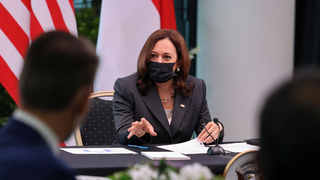When the White House announced that U.S. Vice President Kamala Harris would visit Singapore and Vietnam in August, Asia watchers scratched their heads. Sure, Washington has ground to make up in Southeast Asia. But of the 10 members of the Association of Southeast Asian Nations, why return to two of the countries that U.S. Defense Secretary Lloyd Austin already visited in July?
The answer is simple: The Biden administration is playing it safe. This is not just to keep things easy for Harris, who has relatively little foreign-policy experience. The administration is aiming low because of underlying weaknesses in its approach to Asia, as we argue in a forthcoming United States Studies Centre report. For all the administration’s rhetoric about strategic competition with China, it has yet to present a serious Indo-Pacific policy—or its most important element, an effective economic strategy for the region. Had Harris visited countries other than the two U.S.-friendly stops prepared by Austin, Washington would have had to put much more on the table to secure a warm welcome.
For all the administration’s rhetoric about strategic competition with China, it has yet to present a serious Indo-Pacific policy.
Singapore and Vietnam are safe options for a visit by an inexperienced vice president in a region fraught with potential pitfalls and challenges. Singapore is the only country in Southeast Asia that gives the United States reliable military access. Its leaders are the region’s savviest strategists, recognizing a U.S. military presence as necessary to preserve their own strategic autonomy and the broader regional balance. This makes Singapore eager to do what it can to enmesh the United States in the region.
Since the 2016 election of President Rodrigo Duterte in the Philippines, which put the traditional U.S.-Philippines alliance in a quandary, Vietnam has been the country in the region most willing to overtly defy China. In the South China Sea, Hanoi has seen Washington as an essential part of the strategic balance and its efforts to deter Beijing. While U.S.-Vietnamese military ties remain limited and the Vietnam War still casts its long shadow over the two countries’ relations, Hanoi’s deep distrust of Beijing creates a strong rationale for further expansion of U.S.-Vietnamese ties.
In both Singapore and Vietnam, strategic elites speak a language on China that resonates with their American interlocutors. Both countries see the United States’ presence in the region as vital for their future security. In neither country is public opinion much of a constraint. All of this means that Harris is knocking on open doors. Even if the United States doesn’t get everything it wants in terms of stepped-up defense ties, the atmospherics during both visits were certainly expected to be warm and positive.
This would not have been a sure thing elsewhere in Southeast Asia. Austin got a good result in Manila, where he secured an agreement to maintain the Visiting Forces Agreement, which enables the U.S. military to operate bases in the Philippines. But further progress, such as full implementation of the 2014 Enhanced Defense Cooperation Agreement, which would expand the U.S. military’s footprint in the Philippines and enhance interoperability between both armed forces, is unlikely under Duterte.
The other obvious candidates for a Harris visit, Indonesia and Thailand, would have been more challenging. Thailand’s reluctance to lend support to broader U.S. strategic objectives vis-à-vis China means the Biden administration can expect little from Bangkok, despite the country’s official designation as a “major non-NATO ally.” And Indonesia, despite its weight and potentially powerful regional and strategic role, remains inwardly focused, transactional, and cautious about overtly challenging China. Any progress in security ties will be incremental, unlikely to lend itself to ambitious deliverables for a vice-presidential visit.
Yet the United States cannot achieve its goal of maintaining a favorable balance of power in the Indo-Pacific region without engaging more deeply all across Southeast Asia, not just in a few U.S.-friendly capitals. Southeast Asia’s size and strategic geography—and the fluidity of countries’ alignment decisions—make it the region where U.S.-Chinese competition for influence is most intense.
Biden’s Asia hands seem to understand this. White House Indo-Pacific Coordinator Kurt Campbell has publicly recognized that the United States must do more in Southeast Asia. Beginning with Austin’s visit, Washington has substantially increased official contacts with the region’s key capitals.
Even so, there are worrying signs that the Biden administration more broadly underestimates the urgency and scope of what’s required to effectively constrain China’s rapidly growing influence in the region. While Biden has identified competition with China and Russia as central to U.S. foreign policy, his main focus has been on strengthening U.S. power at home with domestic economic and technological initiatives. Internationally, he has focused on broader global coalition-building, especially with traditional democratic allies in Europe.
This approach means the administration is overlooking urgent issues in the Indo-Pacific. On defense, it has cut funding for short-term deterrence in favor of long-term preparedness to address China as a future threat. On economics, it seems to have no interest in joining the Comprehensive and Progressive Agreement for Trans-Pacific Partnership (CPTPP), the free trade arrangement created by 11 countries after the United States pulled out of regional trade negotiations. Instead, the Biden administration favors infrastructure financing initiatives that might be less contentious than trade with the American public but will take years or even decades to be realized. Meanwhile, Southeast Asia is pulled ever more deeply into China’s economic sphere of influence.
Without an economic strategy for the region, Washington’s influence risks being further undermined. Former U.S. President Barack Obama’s pivot to Asia, of which Southeast Asia would have been the primary beneficiary, was driven by an understanding that the United States would benefit from deeper integration with growing economies in the Indo-Pacific. This conviction led the Obama administration to negotiate the Trans-Pacific Partnership, the predecessor agreement to the CPTPP. Although the pivot failed to deliver, it was the right approach. But Biden’s team is not even trying to return to one of the pivot’s key components: a regional economic strategy to balance China’s growing clout.
Even as Harris’s visit generates goodwill and increases momentum, Washington should not take too much comfort from this trip.
In a region that tends to value economic cooperation more highly than security ties, the absence of a shared prosperity agenda makes it difficult for Washington to approach Southeast Asia in a positive way—and not just as a derivative of strategic competition with China. Having ditched a trade agreement as a priority, the Biden administration has lowered its ambition and is exploring a digital trade agreement instead. It has also offered to host the annual Asia-Pacific Economic Cooperation meeting in 2023. In Southeast Asia, these initiatives will be seen for what they are: a weak substitute for a comprehensive approach to economic cooperation, which is especially crucial as the region seeks to recover from the effects of the COVID-19 pandemic.
The Biden administration also needs to convince the region that its global democracy agenda won’t get in the way of its Indo-Pacific strategy. Convincing Vietnam and Singapore is comparatively easy. While both are authoritarian states, neither will let Biden’s ideological approach stand in the way of closer ties. They are too deeply invested in a robust U.S. regional security presence.
But Singapore and Vietnam are the exceptions, not the rule, in Southeast Asia. Other countries remain circumspect and will need more convincing. Even as Harris’s visit generates goodwill and increases momentum, Washington should not take too much comfort from this trip. Without a comprehensive Indo-Pacific strategy—with a strong and urgent focus on economic issues and Southeast Asia—competing with China in the rest of the region will be much harder.








